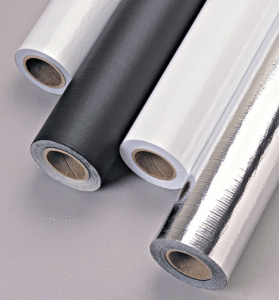Slowing the Flow
by Brooke Smith | 10 May 2024 4:17 pm

Metal buildings are unique in the way they are insulated. A typical metal building insulation application includes an exposed vapor retarder facing the interior of the building because that is usually the warm side of the structure. (An exception to this is when the interior of the building is a cooler or freezer and the inside temperature is lower than the outside temperature.)
Since moisture travels from areas of higher vapor pressures to lower vapor pressures, a vapor retarder should be placed at the point of the highest vapor pressure—i.e., the interior of the warmer side of the structure. Because the vapor retarder—often interchangeably referred to as a vapor barrier—is exposed in most metal buildings, it is essentially the last line of defense against excessive moisture migration into the fiberglass cavity. Contrary to what many people think, a vapor retarder is not designed to completely stop the flow of moisture. Instead, a vapor retarder is designed to retard, or reduce, the movement of moisture.
The amount of moisture that passes through a vapor retarder is dictated by the permeance of the vapor retarder, which is known as a perm rating. Perm ratings are calculated based off the ASTM E96 test for determining water vapor transmission of materials. A perm rating ranges from 0.10 to 10; the lower the perm rating, the less vapor transmission and the more effective the vapor retarder will be. There are two widely accepted vapor retarder classification systems, one from the International Code Council (ICC) and the other from the American Society of Heating, Refrigerating and Air-Conditioning Engineers (ASHRAE).
ICC classifies vapor retarders as follows:
Class I: Less than or equal to 0.1
Class II: Greater than 0.1 and less than or equal to 1.0
Class III: Greater than 1.0 and less than or equal to 10
ASHRAE classifies vapor retarders as follows:
Vapor Impermeable: 0.10 perms or less
Vapor Semi-impermeable: 1.0 perms or less and greater than 0.10 perms
Vapor Semi-permeable: 10 perms or less and greater than 1.0 perms
Vapor Permeable: Greater than 10 perms
Perm ratings for metal building applications range from 0.09 to 0.02, with Class 1 or Vapor Impermeable being the most commonly used in metal buildings. Vapor retarders with a perm rating of 1.0 or above are considered to be at a minimum performance level. Vapor retarders with a perm rating of 0.5 and higher may not be suitable for some metal buildings in certain climate zones. Remember, though, that nothing can stop water vapor transmission 100 percent of the time.
The types of vapor retarders used in the metal building industry are known as flexible membranes, which consist of foils, coated papers, or plastic films. The most commonly used vapor retarders in the industry are made from a polypropylene white or black film and often contain a fiberglass or polyester scrim.
So, how does the perm rating really impact a project? First, vapor retarders do not completely prevent moisture migration; they only slow the process. Though minimal, the water vapor transmission can accumulate over time and turn into liquid moisture dripping down from the affected area. Over time, this could lead to major condensation issues. The better the perm rating, and thus less permeable the vapor retarder, the less likely moisture will pass through.
In addition to the accumulation of water vapor through a highly permeable vapor retarder, there is another more harmful culprit of condensation in the building envelope: punctures and holes in the vapor retarder. Warm air naturally gravitates toward cold air, and a hole in the vapor barrier is the path of least resistance. This moisture transmission method can introduce a large amount of moisture into the cross-section of the thermal envelope, leading to devastating consequences, such as decreased thermal performance and moisture dripping onto products or equipment.
Today’s vapor retarders are equipped with unique properties designed to accommodate nearly every end use, ranging from classic standard duty vapor retarders, which are used in warehouses, to specialty facings for high-abuse environments, such as athletic facilities. It is crucial for contractors and insulation suppliers to discuss the end use of the building to ensure the best—and correct—vapor retarder for the job.
Bill Beals, district manager of Therm-All, is a 38-year veteran of the metal building industry and a contributing member of several committees, including the Metal Building Manufacturers Association (MBMA) Energy Committee and the National Insulation Association (NIA) Laminators Committee. Beals also belongs to the American Society of Heating, Refrigeration, and Air-Conditioning Engineers (ASHRAE) and the International Code Council (ICC). He has contributed to many articles and reference guides on commercial energy codes, and is often invited to share his extensive energy code knowledge at various conferences and educational seminars.
Source URL: https://www.metalconstructionnews.com/articles/slowing-the-flow/